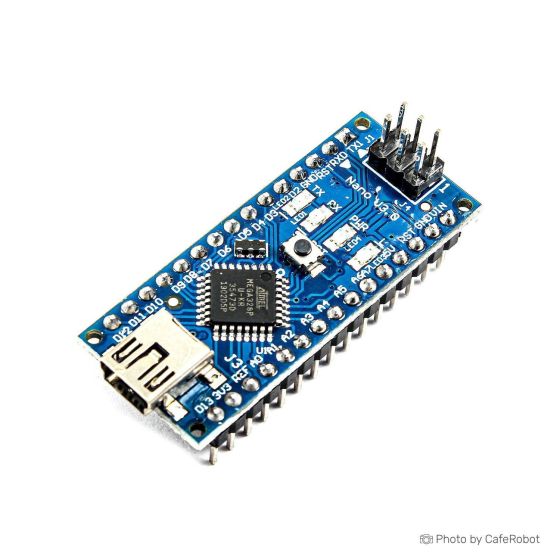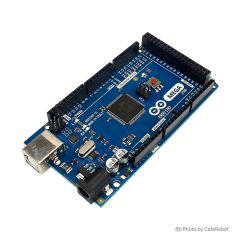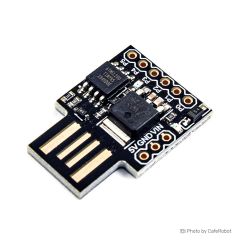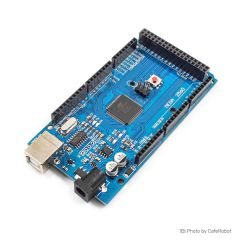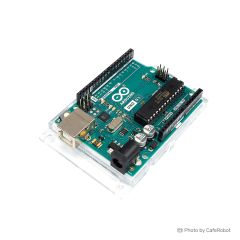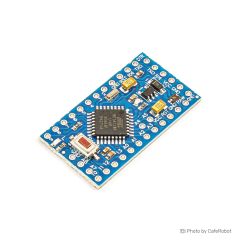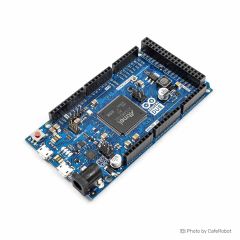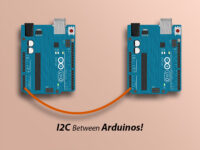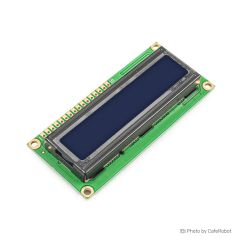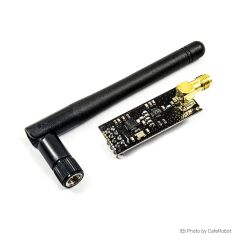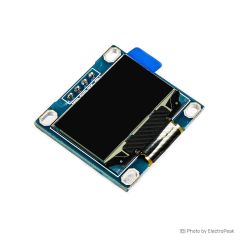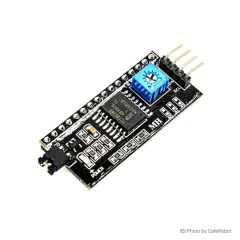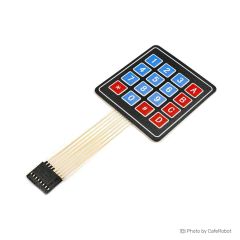برد آردوینو نانو - Arduino Nano V3.0
-
 برد آردوینو نانو Arduino Nano CH340 با رابط مینی USB
برد آردوینو نانو Arduino Nano CH340 با رابط مینی USB
ARD-01-019 -
 برد آردوینو نانو - Arduino Nano V3.0
برد آردوینو نانو - Arduino Nano V3.0
ARD-01-025 -
 برد آردوینو نانو Arduino Nano CH340 با رابط USB Type-C
برد آردوینو نانو Arduino Nano CH340 با رابط USB Type-C
ARD-01-052 -
 برد LGT8F328P بهبود یافته و جایگزین آردوینو نانو ATMEGA328P CH340
برد LGT8F328P بهبود یافته و جایگزین آردوینو نانو ATMEGA328P CH340
ARD-01-057 -
 برد آردوینو نانو Arduino Nano CH340 با رابط میکرو USB
برد آردوینو نانو Arduino Nano CH340 با رابط میکرو USB
ARD-01-051 -
 برد آردوینو نانو اوری Arduino Nano Every
برد آردوینو نانو اوری Arduino Nano Every
ARD-01-053 -
 برد آردوینو Nano نانو اورجینال
برد آردوینو Nano نانو اورجینال
ARD-01-045موجود نیست
- +25 4 % 238٬700 تومان
- +50 5 % 234٬300 تومان
- +100 7 % 229٬800 تومان
- +300 9 % 225٬400 تومان
- +500 11 % 221٬000 تومان
برد Arduino Nano یک برد کوچک و کامل است که بر پایه میکروکنترلر ATmega328 طراحی شده و برای انواع پروژههای الکترونیکی مورد استفاده قرار میگیرد. این برد به راحتی بر روی برد بورد قرار میگیرد و با استفاده از پورت مینی USB قابل اتصال است. برد Arduino Nano از نظر عملکرد مشابه آردوینو Uno است، اما در قالبی کوچکتر و جمعوجورتر عرضه میشود.
مشخصات فنی برد آردوینو نانو - Arduino Nano V3.0
- مدل: ATmega328
- ولتاژ کاری: 5 ولت
- ولتاژ ورودی (پیشنهاد شده): 7-12 ولت (بهترین ولتاژ کمتر از 9 ولت)
- پینهای ورودی/خروجی دیجیتال: 14 عدد (6 عدد PWM)
- پینهای ورودی آنالوگ: 8 عدد
- جریان DC مجاز هر پین: 40 میلیآمپر
- حافظه فلش: 32 کیلوبایت (2 کیلوبایت برای بوتلودر)
- حافظه SRAM: 2 کیلوبایت
- حافظه EEPROM: 1 کیلوبایت
- فرکانس کلاک: 16 مگاهرتز
- ابعاد: 18.5mm x 45mm
- پشتیبانی از Arduino IDE: نسخههای مختلف (OSX/WIN/Linux)
- تغذیه: از طریق USB یا ورودی VIN
- پینهای I/O دیجیتال: 14 عدد (6 عدد PWM)
- ارتباط: UART (سریال)، I2C و SPI
ویژگیها برد آردوینو نانو - Arduino Nano V3.0
- اتصال USB: برد Arduino Nano از طریق اتصال USB به کامپیوتر متصل میشود و برنامهنویسی آن با استفاده از IDE آردوینو امکانپذیر است.
- حجم کوچک: این برد به دلیل ابعاد کوچک، برای استفاده در پروژههای با فضای محدود و در برد بوردها بسیار مناسب است.
- قابلیتهای I/O: با وجود اندازه کوچک، این برد دارای تعداد کافی پینهای دیجیتال و آنالوگ برای اتصال به سنسورها و محرکها میباشد.
نکات استفاده از برد آردوینو نانو - Arduino Nano V3.0
- کابل برنامهریزی: این محصول شامل کابل نمیباشد. کابل مناسب برای برنامهریزی برد Arduino Nano را میتوانید از فروشگاههای مرتبط تهیه کنید.
- پشتیبانی نرمافزاری: استفاده از Arduino IDE برای برنامهریزی برد Nano ضروری است. اطمینان حاصل کنید که نسخه مناسب IDE را نصب کردهاید.
تفاوتها بین Arduino Nano اصلی و نسخههای Clone:
- کیفیت ساخت: بردهای اصلی آردوینو معمولاً با استانداردهای بالاتری تولید میشوند و کیفیت قطعات و لحیمکاری ممکن است بهتر از نسخههای کلون باشد.
- کیفیت قطعات: بردهای اصلی از قطعات با کیفیت بالاتری استفاده میکنند که میتواند به عملکرد و دوام بهتر کمک کند. نسخههای کلون ممکن است از قطعات ارزانتر استفاده کنند.
- قیمت: بردهای اصلی آردوینو معمولاً گرانتر از نسخههای کلون هستند. نسخههای کلون به دلیل قیمت پایینتر برای کاربران بودجهمند جذابتر هستند.
- تفاوتهای طراحی: برخی نسخههای کلون ممکن است تفاوتهای کوچکی در طراحی یا موقعیت قطعات نسبت به نسخه اصلی داشته باشند.
احتیاط:
- تمامی نسخههای کلون لزوماً کیفیت پایین ندارند و ممکن است به خوبی عملکرد داشته باشند، اما کاربران باید از تفاوتهای ممکن در کیفیت آگاه باشند.
این محصول شامل کابل نمی باشد. کابل مناسب برای پروگرام کردن برد آردوینو Nano را می توانید از اینجا تهیه کنید.
An Arduino Nano Clone is a replica or imitation of the original Arduino Nano, which is an official Arduino board. Clones are typically produced by third-party manufacturers and are designed to be functionally equivalent to the official boards. These clones are often more affordable than official Arduino products, making them popular among hobbyists and makers on a budget. While the components and layout may vary slightly from the original, the Nano clone is compatible with the Arduino software and can be programmed using the same IDE, making it a practical choice for those seeking a budget-friendly option for their projects.
Arduino Nano is a microcontroller board based on the ATmega328P, the same chip used in the popular Arduino Nano board. It has 22 digital input/output pins (14 of which can be used as PWM outputs), 8 analog inputs, a 16 MHz ceramic resonator (CSTCE16M0V53-R0), a USB connection, a power jack, an ICSP header and a reset button. It contains everything needed to support the microcontroller; simply connect it to a computer with a USB cable or power it with an AC-to-DC adapter or battery to get started. You can tinker with your Nano without worrying too much about doing something wrong, worst case scenario you can replace the chip for a few dollars and start over again.
Specifications of Arduino Nano Clone:
The Arduino Nano Clone has the same specification of Arduino Nano:
- Microcontroller: ATMega328P
- Architecture: AVR
- Operating Voltage: 5 V
- DC Current per I/O Pins: 40 mA (I/O Pins)
- Power Consumption: 19 mA
- USB-to-Serial Converter: FT232RL chip.
- Input Voltage: Accepts a voltage range of 7-12V when powered via the VIN pin or 5V when powered via the USB port.
- Digital Pins: Offers 14 digital input/output pins, each of which can be used for digital input or output and supports PWM (Pulse Width Modulation).
- PWM Output: 6
- Analog Pins: Provides 8 analog input pins for reading analog sensor values.
- UART, I2C, and SPI: Includes UART (Serial), I2C, and SPI communication interfaces, expanding its connectivity options.
- Flash Memory: Features 32KB of flash memory, of which 2KB is used for the bootloader.
- SRAM: Contains 2KB of SRAM for variable storage during program execution.
- EEPROM: Includes 1KB of EEPROM for non-volatile data storage.
- Clock Speed: Operates at a clock speed of 16 MHz for rapid program execution.
- Dimensions: 18.5mm x 45mm.
- Integrated Components: Include built-in components such as LEDs, reset button, and voltage regulator for ease of use.
- Compatibility: Compatible with the Arduino IDE, allowing you to program it using Arduino sketches and libraries.
- Please note that the exact specifications may vary slightly between different clone manufacturers, so it's advisable to refer to the specific datasheet or product documentation provided by the manufacturer when working with a particular Arduino Nano clone.
Difference between Arduino Nano V3.0 original and its clone
Arduino Nano V3.0 boards can be found both in original versions produced by Arduino and in clones manufactured by various Chinese companies.
We will introduce you the differences that the original Arduino board and the copy may have.
It is necessary to point out that the version that is sold on our site is an exact clone of the original board and in terms of functionality and quality, they are not different from the original version.
Here are some general differences that are often observed between original Arduino Nano V3.0 boards and their Chinese clones:
- Build Quality: Original Arduino boards are typically manufactured to higher quality standards. The components used, soldering quality, and overall build may be superior to some Chinese clones.
- Component Quality: Original Arduino boards often use higher-quality components, which can contribute to better performance and durability. Chinese clones may use cheaper components to reduce costs.
- Pricing: Original Arduino boards are generally more expensive than Chinese copies. The lower cost of Chinese copies may make them attractive to budget-conscious users.
- Clones and Variations: Some Chinese clones are exact clones of the original Arduino Pro mini, while others may have slight variations in design or component placement.
- Manufacturing Origin: Original Arduino boards are manufactured in Italy or other authorized locations. Chinese clones, as the name suggests, are often manufactured in China.
It's important to note that not all Chinese copies are of poor quality, and some function perfectly well. However, users should be aware of potential differences in quality when choosing between an original Arduino Nano V3.0 and a Chinese clone.
Considering the price difference in most cases, buying a quality copy of Arduino is a more suitable option for most users
